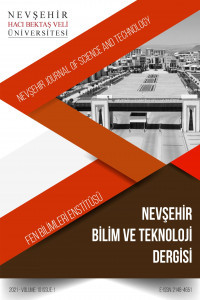Borlama İşleminde Kullanılan Bor Tozu Tane Boyutunun Kaplama Tabakası Üzerine Etkisi
Bu çalışmada, paslanmaz çelikler içerisinde endüstride yaygın olarak kullanılan AISI 304 östenitik paslanmaz çeliğin yüzeyi 900°C’de 3 saat süre ile, 10-50 nm boyuta sahip elementel nanobor tozu, 50-100 nm boyutuna sahip hegzagonal bor nitrür tozu ve 1400 µm boyutuna sahip EKabor 3 tozu ile borlanmıştır. Borlama işlemi sonrası numuneler optik mikroskobi ve SEM analizi ile birlikte mikrosertlik testine tabi tutulmuştur. Böylece toz boyutlarındaki farklılığın kaplama tabaksına etkileri araştırılmıştır. Yapılan incelemeler sonucunda borür tabakasının; kalınlık, sertlik ve kırılma tokluğu değerlerinin borlama tozunun tane yapısının küçülmesi ile arttığı tespit edilmiştir.
In this study, AISI 304 austenitic stainless steel widely used in industry boronized with elemental nano boron powder of 10 to 50 nm in size, hexagonal boron nitride powder of 50 to 100 nm in size and EKabor3 powder of 1400 μm in size at 900 °C for a period of 3 hours. After boronizing of the samples, specimens were tested with optical microscopy and SEM analysis. Thus, the effects of powder size differences on coating layer were investigated. As a result of the examinations, i t has been identified that thickness, hardness and fracture toughness values increased with the decrease of boriding powder grain structure.
Keywords:
Boriding, AISI-304, microstructure, nanoboron,
___
- Başman G., Şeşen M.K.,The improvement of the surface properties of AISI 316L type stainless steel by boronizing, İ.T.Ü EngineeringJournal,10, 115-121, 2011.
- Çelebi G., Ipek M., Bindal C., Ucisik A. H., Some mechanical properties of boridesformed on AISI 8620 steel,Materials Forum, 39, 456-60, 2005.
- Özdemir O., Omar M. A., Usta M., Zeytin S., Bindal C., Ucisik A. H., An investigation on boriding kinetics of AISI 316 stainless steel,Vacuum, 83, 175-179, 2009.
- Uslu I., Comert H., Ipek M., Ozdemir O., Bindal C., Evaluation ofborides formed on AISI P20 steel,Materials and Design, 28, 55-61, 2007.
- BayçaS.U.,ŞahinS.,Borlama,MühendisveMakine,532,51-59, 2004.
- Kayalı Y., Günes İ., Ulu S., Diffusion kinetics of borided AISI 52100 and AISI 440C steels, Vacuum, 86,1428-1434, 2012.
- Taktak S., Some mechanical properties of borided AISI H13 and 304 steels, Materials and Design, 8,1836-1843, 2004.
- Meric C., Sahin S., Yilmaz S. S., Investigation of the effect on boride layer of powder particle size used in boronizing with solid boron-yielding substances, Materials Research Bulletin, 35, 2165-2172, 2000.
- Yılmaz S.S., Ünlü B.S., Varol R., Borlanmış ve bilyalı dövülmüş demir esaslı T/M malzemelerin aşınma ve mekanik özellikleri, Makine Teknolojileri Elektronik Dergisi, 1, 7-16, 2008. Günen A., “Nanobor tozu ile yüzeyi alaşımlandırılan östenitik paslanmaz çeliğin mekanik özellikler ve korozyon davranışının araştırılması”, Fırat Üniversitesi, Fen Bilimleri Enstitüsü, Doktora Tezi, Elazığ, 2012.
- Sinha A.K., Boriding (Boronizing), ASM Handbook, J. Heat Treating, Ohio, USA., 4, 437-447, 19 MatuschkaA.G., Boronizing,CarlHanserVerlag,München, 1980.
- Bindal C.,Üçışık A.H., Characterization of borides formed on impurity-controlled chromiumbased low alloy steels, Surface and Coatings Technology, 122, 208-213, 1999.
- Şen U., Şen S., The Fracture Toughness of Borides Formed onBoronized Cold Work Tool Steels, Materials Characterization, 50,261-267, 2003.
- Yapar U., Basman G., Arısoy C. F., Yesilcubuk S. A., Şeşen M.K., Influence of Boronizing on Mechanical Properties of EN-C35E Steels,Key Engineering, 264-268, 629-632, 2004.
- ISSN: 2148-466X
- Yayın Aralığı: Yılda 2 Sayı
- Başlangıç: 2012
- Yayıncı: Nevşehir Hacı Bektaş Veli Üniversitesi
Sayıdaki Diğer Makaleler
As (III)’ün As (V)’e Ultrasonik Oksidasyonu
Mathematical Modelling of Alkaline Sludge Disintegration
Hatice Özlem İNCE, Cengiz BAHADIROĞLU, Sevil TOROĞLU, Hakan BOZDOĞAN
Araç Çayı Makroomurgasızları Üzerine Bir Ön Çalışma
Gıda Patojenlerinin Tanısında Kullanılan NanoBoyutlu İmmünosensör Tasarımı
Erdogan ÇİÇEK, Sevil BİRECİKLİGİL, Fadime ÇELEKLİ, Abuzer ÇELEKLİ
Borlama İşleminde Kullanılan Bor Tozu Tane Boyutunun Kaplama Tabakası Üzerine Etkisi
Ultrasonik Aktifleştirilmiş Aktif Karbon ile Krom (VI) Adsorpsiyonu
